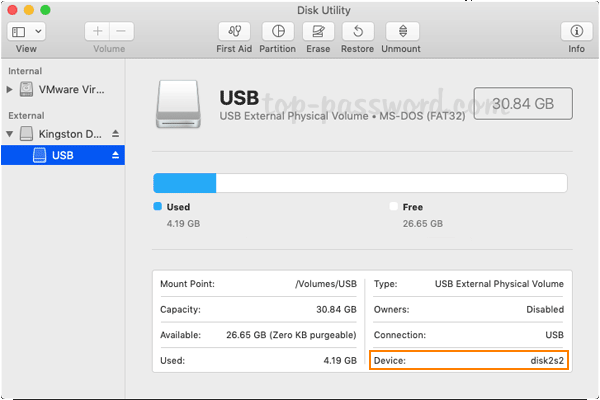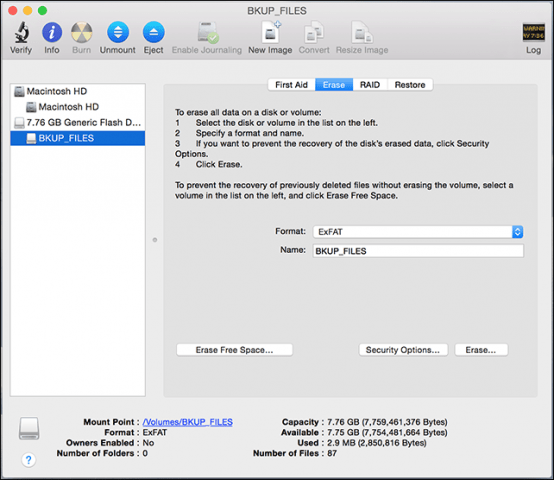Format Flash Drive To Mac

Nowadays, when you buy a USB drive, you can use it right out of the box with your Mac. However, unless it’s been designed for use with a Mac, it won’t be formatted using macOS’ preferred file system (either Mac OS Extended or APFS, depending on which version of macOS you’re running).
That’s because most of the computers in the world run Windows, and Windows uses a different file system, usually one known as Fat32. Drives formatted as Fat32 can be read from and written to by macOS, but it’s not optimal and you’re more likely to run into problems than if you use macOS’ native format. So, if you’ve bought a USB drive that’s formatted as Fat32, or any other format other than Mac OS Extended (also known as HFS+) or APFS, here’s how to format a USB drive on Mac. It’s exactly the same procedure if you need to reformat a flash drive on a Mac.
How to format a USB drive on a Mac
To format a flash drive on a Mac, plug in the drive and open the 'Applications' folder, the 'Utilities' folder and then 'Disk Utility.' Your flash drive should be listed in the left menu. As simple as the process seems, it tells you a lot about your system. For example, if a USB flash drive that contains a bootable copy of macOS doesn’t show up on the Startup manager, you may need to repair the disk permission. Also, remember to format the USB drive with a APFS or Mac OS Extended format.
1. Plug the drive into a USB socket (if you have a recent MacBook or MacBook Pro that only has USB-C connectors, you’ll need a USB-C to USB-A adaptor).
2. Open a new Finder window and click on the drive. Make sure it has no files on it that you need. The process of reformatting it will wipe all the data from it.
3. Once you’ve copied any files you need from the USB drive to your Mac, go to Applications>Utilities and double-click on Disk Utility.
4. Click on the USB drive in the sidebar and then choose Erase from the toolbar at the top of the window.
5. In the window that drops down type a name for the formatted drive in the box next to Name.
6. Choose a format from the dropdown menu.

7. If you have previously stored sensitive data on the drive, click the Security tab.
8. Choose a security level using the slider. The further to the right you move the slider, the more ‘passes’ the erase tool will make and the more securely files will be deleted. However, it also increases the time it takes to format the drive quite considerably.
9. Click Ok then click Erase.
Tip: You don’t need to erase a whole drive to delete files securely. If you have confidential files or sensitive data you need to remove from your Mac completely, you should use CleanMyMac’s File Shredder. It’s specifically designed to securely delete sensitive data and will render it unrecoverable. You can download CleanMyMac X for free here.
Which format to choose?
If your Mac is running macOS High Sierra or later, you have two options for file formats: APFS and Mac OS Extended. Which should you choose? The key point is that disks formatted as APFS won’t be recognized by Macs running versions of macOS older than High Sierra. So if you think you might need to plug the USB drive into a Mac running an older version of macOS, format it as Mac OS Extended.
APFS is optimized for SSD (solid state drive) such as flash drives, so if you reformat a flash drive on a Mac, you should definitely choose APFS (unless you plan to use it with a pre-High Sierra Mac, of course). Even on hard drives, however, APFS is faster and more reliable than Mac OS Extended.
Finally, if you plan to use the USB drive as a destination for Time Machine backups, choose Mac OS Extended. Time Machine can’t currently back up to an APFS disk and if you select one for use with Time Machine, it will offer to reformat it as Mac OS Extended. You can, however, backup an APFS formatted disk to a Mac OS Extended Time Machine drive.
How to format a USB drive to FAT32 on a Mac
The main reason for formatting a USB drive as Fat32 on a Mac is that you want to be able to use the drive on a Windows PC, as well as a Mac — perhaps to transfer files between the two machines. You may also be preparing the drive for use as, say, a storage device for a media player or to record TV programmes on a TV with a USB port.
The fact that Fat32 can be read from and written to on both Mac and Windows makes it very versatile. However, there is a significant limitation — individual files have a maximum size of 4GB. So, if you’re using the USB drive to store large video files, you may run into trouble. There is a solution, however, exFAT. Unlike FAT32, exFAT doesn’t have a maximum file limit. Better still, it can be read from and written to on any Mac running Mac OS X Snow Leopard or later and on Windows.
To format a USB drive in FAT32 or exFAT:
1. Plug the USB drive into your Mac.

Format Flash Drive To Ntfs Mac
2. Go to Applications>Utilities and launch Disk Utility.
Format Flash Drive To Mac
3. Click on the USB drive in the sidebar in Disk Utility.
4. Click Erase in the Disk Utility toolbar.
5. Type in a name for the formatted disk.
6. Click on the Format menu and choose either MS-DOS (FAT32) or ExFAT.
7. Click Erase.
Your USB drive will now be erased and re-formatted as either FAT32 or ExFAT, depending on the format you chose in step 6.
How to manage your drives easily
If you look for a quick and easy way to manage your drives, try using CleanMyDrive 2. With its help, you can drag-and-drop files directly to any drive, clean hidden junk from external drives, and check disk stats. It works for all drives, including USB drives, SSD, SD cards, external hard drives. All the drives will be at hand in the menu bar, so you can get to see types of drives you have and manage them easily. CleanMyDrive is absolutely free to use, so download it on the Mac App Store and enjoy!
It’s very easy to format a USB drive on a Mac using Disk Utility. There are a couple of things you should keep in mind, however. The first is that when you format and disk, you will erase all the data currently on it. So if you need that data, make sure you copy it onto another disk before you start. Secondly, there are several formats to choose from, each with advantages and disadvantage. Use the guide above to help you decide which is right for you.
These might also interest you:
If you want to format a USB flash drive on Mac, there are many methods for users to choose. For example, you can use the Mac system built-in Disk Utility to format a USB flash drive. Or you can choose a third-party tool to accomplish the task. On this page, we will just introduce a third-party software - TS DataWiper for Mac - to format USB flash drive on Mac.
Why users need to format USB flash drive on Mac? Actually, there are varieties of reasons that Mac users want to format a USB flash drive. Here we will show you some of the popular reasons:
- Format USB flash drive to change the files system for special usage. For example, you may want to use the USB flash drive on both Windows and Mac machines. Then you can format the USB flash drive to FAT32 or ExFAT.
- Fix file system errors by formatting the USB flash drive. If there are errors in the file system, you may have problems to access the USB flash drive. A format can help you format the drive and fix the issues directly. Then you can access the drive without problem.
- Format and wipe USB flash drive before you give it to other person. If you need to lend or give the USB flash drive to other person, you may want to format the drive and wipe all the data on it.
Now we will share you about how to format USB flash drive on Mac on this page. Here we will introduce 2 methods to help you format USB flash drive on Mac. The first method is to format USB flash drive in Disk Utility. The other method is to format with TS DataWiper for Mac.
Format USB flash drive with Disk Utility on Mac
Before formatting USB flash drive, please ensure to move the files from the drive to another drive first. Especially if there are issues with the USB flash drive and you cannot access the files/drive, please first try to recover files from USB flash drive first. You can choose TogetherShare Data Recovery for Mac to recover the data first in such a case. After you back up or recover the data from the USB flash drive, then you can try to format it in Disk Utility as follows.
Step 1. Connect USB flash drive to the Mac computer first.
Step 2. Go to the Disk Utility, select the USB drive and choose the Erase option.
Step 3. Type the name and choose format, such as MS-DOS (FAT32), ExFAT, etc. from the format menu.
Step 4. Click Erase and the operation might take some time depends on the USB drive size.
After the process is finished, you can then have a totally empty and workable USB flash drive.
Format USB flash Drive by using TS DataWiper for Mac
TogetherShare Software provides a third-party tool TS DataWiper for Mac to help users format and wipe USB flash drive effectively. Please first download the software.
TS DataWiper

The most powerful data erasure software to permanently erase data.
You can format the USB flash drive in the software simply. Please choose Disk Format option. Select the USB flash drive and click the Format button to format the USB flash drive.
However, the lost data can be recovered if you simply format the USB flash drive in both the 2 mentioned methods. If you want to format the USB flash drive and also wipe the data on the drive permanently, you can use the following option instead.
Step 1. Choose the tool Erase Hard Drive, and select your USB flash drive.
Step 2. Click on Erase Now button to permanently erase all data on the USB flash drive. It will format the drive after wipe the drive.
With the software, you can not only format and wipe drive, but also it can wipe the lost data or shred files on USB flash drive, memory card, SSD, internal/external hard drive, and other storage media. Please download and use the software to wipe data or drive permanently.
TS DataWiper
The most powerful data erasure software to permanently erase data.
Related Articles